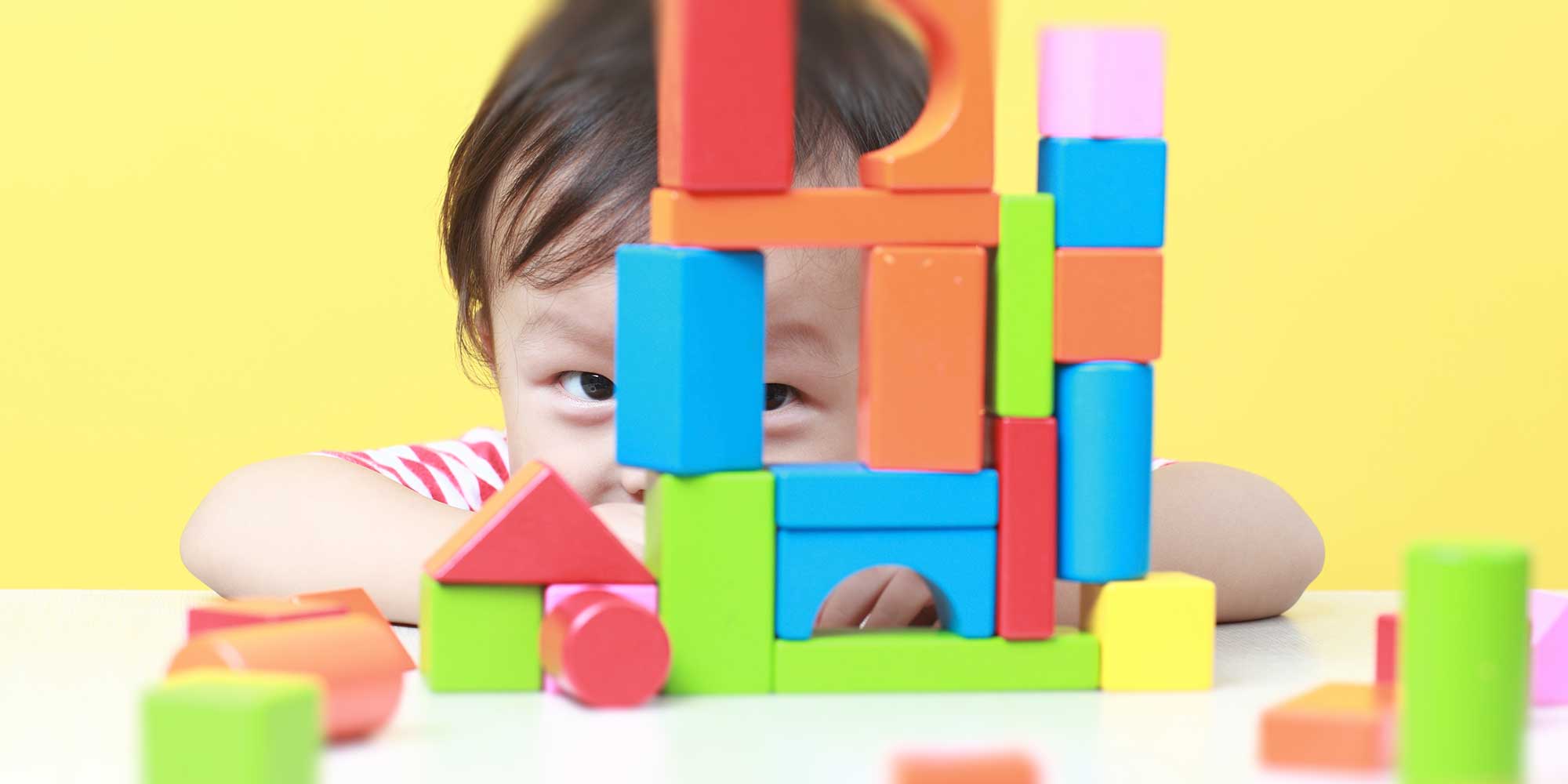Preschool Education in China
Market Overview
Preschool education is regarded as one of the sunrise industries in China. Since preschool education is not included under China’s compulsory education system, preschool enrolment is entirely up to the discretion of families or parents. The majority of new parents in China were born in the 80s and 90s and received a higher quality of education compared to older generations, affording them a correspondingly different outlook and tendencies in regards to decisions involving schooling.
China’s education system is notoriously rigorous and characterised by intense competition. As a result, many parents choose to have their children enrol in kindergartens or early childhood education centres to boost their competitiveness and ensure they are adequately equipped to succeed. Children aged from 0-3 are enrolled in early childhood education centres, which are usually established by private entities. Meanwhile, children aged from 3-6 attend private or public kindergartens, and may also participate in extracurricular classes such as those for dancing and drawing. At present, the market size of preschool education in China is estimated to be around CNY 350 billion. The market for children aged from 0-3 is about CNY 150 billion, while the market for children aged from 3-6 is about CNY 200 billion.
| Age Range | Content of Lessons |
|---|---|
| 0-3 | Perceptual Training, Body Function Training, Thinking Enlightenment |
| 3-6 | Language Training, Music and Art Training, Thinking Training |
Market Preference for Early Childhood Education Centres
Although infants are the main consumers of early childhood education services, their parents are the major decision makers. According to research conducted by learning.sohu, parents primarily consider faculty resources, distance to home, and teaching methods when choosing an early childhood education centre. Currently, the majority of early childhood education centres are located either in department stores or near residential areas. Around 51.05% of children take lessons once a week, while 19.74% and 11.45% take lessons twice a week and more than twice a week, respectively. The remaining 17.76% take lessons less than once a week. Foreign brands price one-hour lessons at CNY 150-200, while similar lessons from local brands are priced at CNY 120-160. When presented with the choice of local brands and foreign brands, only around 30% of parents have a preference for the latter. Around 75% of parents have a price tolerance of up to CNY 4,000 for one semester.
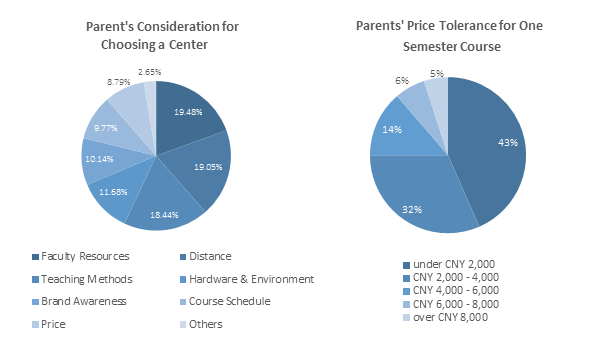
Increasing Infant Population in China Ensures Market Potential
China has a population of over 1.3 billion. Each year, there are around 16 million infants born in China, with a birth rate floating around 1.2%. Based on each year’s infant population, as of 2015, there were more than 114.3 million children aged from 0-6 in China, of which there were 66.2 million children aged from 0-3. In October 2015, the Chinese government announced that they would replace the one-child policy with a universal two-child policy, allowing each married couple across the country to have two children. This policy is expected to increase the birth rate and solve the aging population issue. According to experts, the incremental infant population is expected to be around 5 million infants each year after the implementation of the two-child policy. In 2017, the infant population is estimated to reach a peak of 21.7 million. As the main consumers of preschool education, the increasing infant population is a strong indicator of potential growth in the preschool education market.
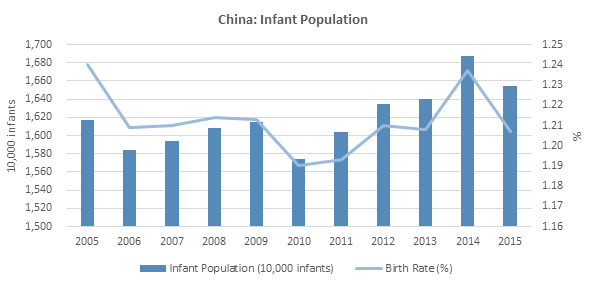
Growing Demand for Preschool Education from Kindergartens
Despite the fact that kindergarten education is not subsidised by the government, an increasing number of parents are sending their children to kindergartens from age 2-3, usually for a period of three years. In fact, many primary schools in China require children to first receive preschool education so that the children will have better sociability. As of 2015, there were 77,300 public kindergartens and 146,400 private kindergartens in China. As the government has focused its efforts into increased funding for preschool education, the percentage of public kindergartens has risen from 31.99% to 34.56% from 2010 to 2015. In 2015, 19.62 million and 23.02 million children were enrolled in public kindergartens and private kindergartens, registering CAGRs of 4.47% and 10.47% from 2010 to 2015 respectively. Under the National Medium- and Long-term Education Reform and Development Plan (2010-2020), the net enrolment rate was expected to reach 70% for three-year preschool education, 80% for two-year preschool education and 95% for one-year preschool education by 2020. As of 2015, the actual net enrolment rate has increased from 50% in 2009 to 75% in 2015. However, compared to developed countries with a net enrolment rate of around 90%, there is still space for development. In line with the yearly increases in the country’s infant population, the demand for preschool education from kindergartens is expected to see further growth going forward.
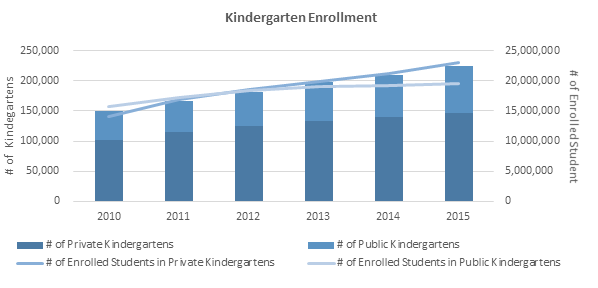
Increasing Expenditure on Education Contributes to Market Growth
The living standards of Chinese citizens have witnessed a vast improvement in recent years. In 2015, the nationwide annual per capita disposable income was CNY 21,966, up by 8.9% YoY, while the annual per capita disposable income for urban residents was CNY 31,195, up by 8.2% YoY. Considering the gradually increasing level of urbanisation, which grew from 49.68% in 2010 to 56.10% in 2015, the nationwide annual per capita disposable income is expected to further increase in future. This growing household wealth directly supports parents in providing higher quality education to their children.With the upturn in living standards in China, people are beginning to spend more money on education, culture and entertainment. As of 2015, the annual per capita consumption on education, culture and entertainment increased by 12.18% YoY to CNY 1,723. Although the survey subject range for these statistics was changed from 2013, an upward trend in the annual per capita consumption can still be observed. The annual per capita expenditure on education, culture and entertainment is estimated to reach CNY 5,000 by 2020. In addition, the CPI of education, culture and entertainment presented an upward trend over 2009 to 2015, with a particular increase in the rate of growth since 2012. Consumers’ increasing willingness to spend on education, coupled with higher prices, will likely continue to drive growth in the education, culture and entertainment market.
| 2010 | 2011 | 2012 | 2013 | 2014 | 2015 | |
|---|---|---|---|---|---|---|
| Urban Resident | 1,627.6 | 1,851.7 | 2,033.5 | 1,397.7 | 1,535.9 | 1,723.0 |
| Rural Resident | 366.7 | 396.4 | 445.5 | 1,397.7 | 1,535.9 | 1,723.0 |
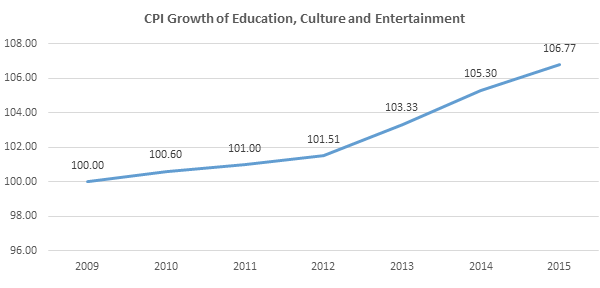
Pursuit of High Quality Education and Increasing Brand Awareness May Drive Industry Reform
In recent years, the surge in the number of private and public kindergartens has relieved China of its undersupply issue. But with more than 220,000 kindergartens across the country, it is difficult to achieve a unified standard in terms of the quality of education. In addition, the kindergarten market in China has low market concentration. Most players operate on a small scale, with usually one kindergarten, and thus lag behind in education quality and management expertise. According to Guolian Securities, the top 5 kindergarten operators operate more than 2,600 kindergartens across the country, but only represented a market share of around 1.26%. Players in the industry should therefore focus on establishing a brand presence and managing affiliates in a systematic fashion in order to improve their performance and boost the overall quality of the market. In 2015, the Standing Committee of the National People’s Congress passed a bill to revise the Education Law of the People’s Republic of China. The revised law states that the country will establish a standard measure for preschool education, which is expected to elevate the quality of education as a whole.
Quick Growth for O2O Early Childhood Education Hard to Realise
The O2O concept has been gaining popularity in China in recent years. Following this trend, several companies have applied the O2O concept to early childhood education. One such example of this is Zao Jiao Dao Jia, an O2O company offering door-to-door early childhood education for infants aged from 0-3. The company finished its pre-A series funding of CNY 10 million in November 2015. Unlike the one-to-many standardised lessons offered by traditional education centres, door-to-door early childhood education services are usually one-on-one and customised. Currently, O2O early education services charge prices which are similar to those offered by traditional one-to-many education services, in the hope of taking market share from the latter.
Nevertheless, according to learning.sohu, more than 58% of parents send their children to early education centres so that their children can mix with peers and build up their social skills. As such, although door-to-door early childhood education may offer advantages such as better quality of education and avoidance of travel and lump-sum settlements, it does not administer the same socialisation benefits inherent in the services of traditional providers. Further, the majority of parents only have a need for such services around 1-2 times per week, compared to other O2O services like food delivery, for which customers may utilise as frequently as once per day. In addition, parents looking into one-on-one education services usually expect teachers to have related experience of at least 3-5 years. However, such experienced professionals are less willing to work for O2O companies since they are usually able to find more secure, higher-paying positions in traditional education centres or in kindergartens. Thus, in spite of the large potential market for O2O early childhood education services, the market is unlikely to experience rapid growth due to the low frequency of usage and the difficulty in hiring experienced teaching professionals.
Investments in Online Preschool Education Heating Up; Foreign Capital Restricted
Institutional investors are investing actively in the country’s online preschool education industry, which has been driven by factors such as the rapid development of the internet, 4G network and smartphones. Online education is particularly popular amongst parents who are in their 20s and 30s, as they are more familiar with internet and smartphone services. In 2016 H1, the number of funding cases in online education increased by 25.29% YoY to 109. The total amount of funding was CNY 3.4 billion and preschool education accounted for 7.81%. Some companies were listed on the National Equities Exchange and Quotations (NEEQ), a new Chinese stock market catered for small- and medium-size companies. Such listings open up a way for small- and medium-size preschool education companies to raise funds.
Foreign investors are faced with restrictions on investment in preschool education institutions in China. According to the Catalogue of Industries for Guiding Foreign Investment (2015 revision), jointly published by the National Reform and Development Commission and the Ministry of Commerce of the PRC, foreign investors can only invest in preschool education institutions through joint ventures. In addition, the president or the main administrator must hold Chinese nationality, while no less than one-half of the members on the institution’s trustee council, board of directors, or the joint administrative committee should be Chinese.
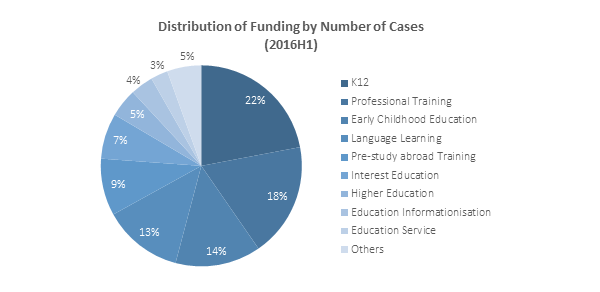

Major Players Aiming for Industrial Integration
American brand Gymboree Corporation began with the founding of Gymboree Play & Music in 1976, but later the company expanded its business to include apparel and accessories retail for children. Many Chinese players have followed a similar business strategy. For example, RYB Education Institute, one of the largest domestic early childhood education service providers in China, has undergone business expansion and industrial integration over the past few years. The company first established an RYB Learning Centre in 1998, offering parent accompanied early education services. In the following years, the company expanded its business by introducing RYB Kindergarten and Zhudou Parenting. Zhudou Parenting sells early education products and operates a mobile App for early childhood education. The company also established its own teaching research centre and training school for kindergarten teachers. In 2015, the company partnered with maternal and infant e-commerce platform Mia.com, and established a new brand called Chainbest.tv. Chainbest.tv is responsible for displaying maternal and infant products on screens in RYB learning centres. Parents can scan the QR code and purchase the products online, which will be prepared and shipped from Mia.com.
Increasingly Fierce Competition Driven by Franchise Model and Entry of New Players
There are nearly 13,000 early childhood education centres in mainland China, around 18% of which are foreign capital funded. One reason for the rapid expansion of early childhood education centres is its franchise business model. Around 70% of early childhood education centres in China utilise the franchise model. Big brands usually start with chain stores and transfer to a franchise model once the brands have gained a strong reputation. The brand/company will then charge an initial fee and annual royalty fee as a certain percentage of total revenue. According to Jiamengfei.com, with the exception for Gymboree, the franchise centres of the other three major brands, namely GYMBABY, MY GYM and Babycare, require first-year inputs and expenses of around CNY 1 million for a centre of 400-500 square metres. Additionally, the CNY 1 million investment is likely to be paid back within 1-2 years, which can be fairly attractive to investors. In addition to foreign brands, many local brands in China also apply foreign teaching methods as a selling point for their services. This is because foreign teaching methods, especially those from the US, are largely held in high regard by those parents born in the 80s and 90s. Such methods place value on children’s creativity, teamwork and character building over their ability to excel in standardised testing. For instance, GYMBABY leveraged western educational theory and teaching methods as a reference point to develop its own training lessons, and received extensive attention from the industry for its innovative approach. Meanwhile, a number of Chinese players, either in related or non-related businesses, are also seeking to enter the early education market. In 2014, Zhejiang Semir Garment, a Chinese local apparel company, acquired a 70% stake in Yuhan (Shanghai) Information Technology (provider of brands FasTracKids and FasTrack English) from Everlearn International Group with a deal value of CNY 102 million. In June 2016, Gymboree Corporation sold its Play & Music business (i.e. early childhood education services) to ZEAVION Holdings, a Singaporean education services company established by a Chinese entrepreneur. With more and more large enterprises entering the industry, the early childhood education sector is expected to develop rapidly, and competition will likely intensify.
| GYMBABY | Gymboree | RYB | MY GYM | Babycare | |
|---|---|---|---|---|---|
| Country of Origin | China | USA | China | USA | China |
| Age | 0-6 | 0-5 | 0-6 | 0-8 | 0-6 |
| # of Centres in China | 100 | 200 | 1,200 | 200 | 700 |
| Franchise | ○ | ○ | ○ | ○ | ○ |
| First-Year Expense Estimate for a Franchise Centre (CNY) | 1,521,000 for 500 ㎡ centre | 3,126,000 for 600 ㎡ centre | – | 1,010,000 for 400 ㎡ centre | 1,426,000 for 500 ㎡ centre |
| Annual Net Profit Estimate (CNY) | 984,000 | 1,648,800 | – | 1,050,000 | 1,390,000 |
| Content of Lessons | Art, Sports, Life Practice, Language, Brain Potential | Play & Learn, Music, Art, Preschool Steps, Family, School Skills | Parent accompanied lessons Language, Art, Logic, Bridge lessons | Music Together, Abrakadoodle | Enlightenment, Music & Art, Logic, Language |
| Expanded Business | – | Children’s Apparel and Accessories | Kindergarten, Early education products, Mobile app, Maternal and infant products O2O | – | Maternal and infant products O2O |
Conclusion
The preschool education industry presents a huge potential market in China due to the country’s large infant population, parents’ increasing focus on education, rising household disposable incomes, and the subsequent growth in education expenditure. Although the preschool education industry in China is slightly lagging compared to other countries, the industry is now expanding aggressively with more and more large enterprises and capital flowing into the market, leading to intensified competition. In future, the Chinese government is expected to announce rules to officially regulate the market. However, at the current stage of the industry’s development, players must self-regulate to ensure the quality of education provided and increase their competency in order to survive.
